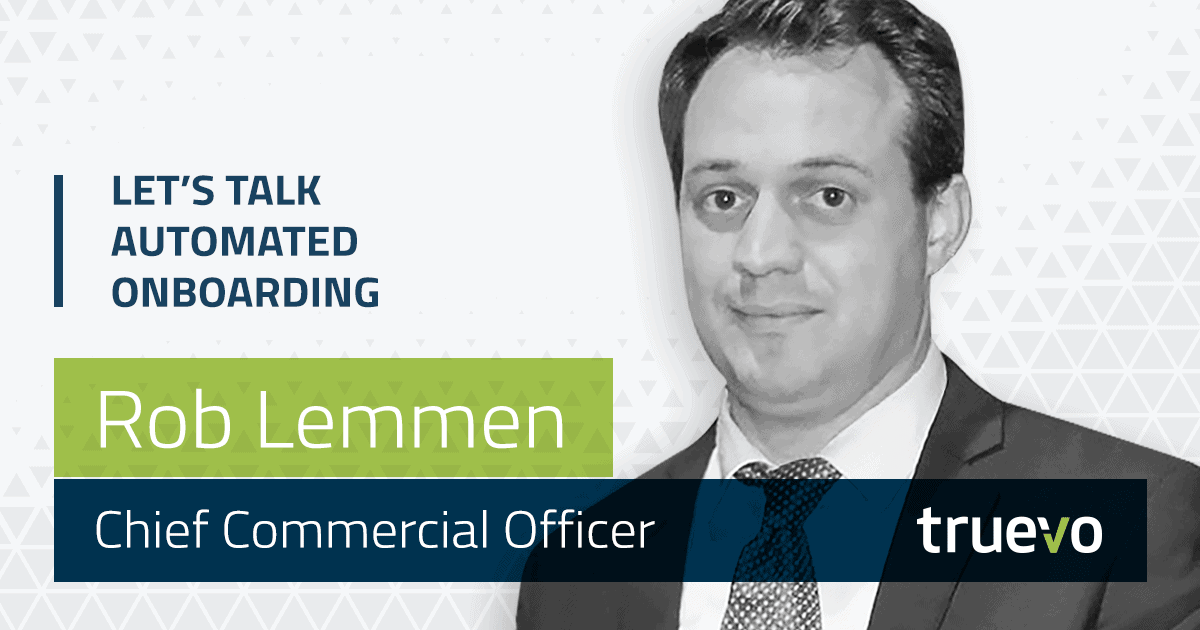Automation is important to stay competitive and ahead of the curve. However, to be competitive in the long run, it doesn’t mean one has to cut corners.
– Rob Lemmen, Chief Commercial Officer of Truevo
What are the current challenges of optimising the onboarding process for a large volume of merchants in a frictionless and compliant manner?
The biggest challenge related with the onboarding process is to be appropriately vigilant while ensuring you offer merchants the fastest and easiest onboarding experience possible. When working with a high volume of merchants, it only makes sense to systemise and automate as many as possible, or most of your processes to take advantage of economies of scale. The way we’ve worked to do that at Truevo is to create a scoring system for merchants.
Businesses that fall into the lower scores can be moved through onboarding quickly, and it’s great to be able to automate their process and provide them with a frictionless experience. By systemising our onboarding process, we’re able to move that much more quickly with businesses who require that one or two extra pieces of paperwork.
That being said, the process still needs to be vigorous. A merchant may be qualified as low risk with regards to ownership structure, or other indicators of AML risk. For example, a business might come through posing as selling eyewear while there is a risk that the merchant is selling something completely different, and is a front website for illegal activities. For this reason, it is critical even while automating to ensure that appropriate checks are in place and that all merchants are reviewed, no matter how small or how seemingly low the risk is.
One of the trickiest things about putting a scoring system in place is how to manage the small percentage of businesses that don’t fall within standard categories. Let’s consider 5% of business coming through are not cut and dry how they should be scored. 5% of a large volume of merchants – let’s say the example is 2,000 – is still 100 complex cases which need to be handled manually. This type of onboarding is time-consuming, and it is difficult to be able to appropriately categorise and decide how to manage every type of business that would like to process transactions.
The nice thing is that once the decision of how to manage that difficult last bucket of merchants is made, you are left with a stringent scoring system that takes the ambiguity out of the onboarding process. The possibility of a wrong decision being made by a subjective individual no longer becomes an issue.
What best practices should payments companies apply to enhance the process and remove the current pain points?
One way is to approve merchants with simple business structures and straightforward products nearly instantaneously. This is a reality with our point of sale merchants. We have created an auto-onboarding process which approves merchants very quickly online with no paper required, with all identification checks and signatures done electronically. You would be amazed how long merchants find themselves waiting for approval and for a payments terminal. There is still a big part of that market that is traditional and ripe for disruption today.
Yet another way is to create an onboarding system which is market-specific. Take sole traders, for example. If an applicant is a sole trader, make sure that your onboarding process does not require the applicant to provide company documents. They are not necessary for this category. Another example is how we’ve partnered with a bank to onboard merchants. By working with merchants who already have an account with that bank, it becomes unnecessary to collect any bank related information because all that can be shared between the bank and Truevo.
Automation is the key to enhance onboarding processes and to remove pain points – it’s time-saving and provides a way to make onboarding frictionless for merchants.
How can you survive in this competitive landscape? Is it merely a difference between quantity and quality?
Automation is important to stay competitive and ahead of the curve. However, to be competitive in the long run, it doesn’t mean one has to cut corners. We have seen a trend in the market where other providers are attempting to issue auto approvals, but not through the automation of their checks, but just bypassing some checks. You can advertise a solution as being flexible and modern while, at the same time, missing businesses which should not be processing and which will garner big penalties for acquirers who are less scrupulous.
A person needs to only glance at the news to know that even some of the big acquirers have collected fewer checks and done less KYC than is required by the industry. The way we stand out in this matter is by making sure to never onboard a merchant that is noncompliant. The bottom line is that it is possible to automate more and not skimp on checks while still onboarding a large number of businesses and being thoroughly compliant.
Should acquirers work with an outsourced party, or should they build their own technology and solution for the whole process?
It’s always recommended to work with partners that are experts in their field. It is neither fast nor efficient to build all the onboarding pieces. We know businesses that excel at identification, PEP and sanction screening, fraud prevention, and extracting corporate documents and we work with each of them to create the best onboarding system possible. It is important that we all focus on what we do best. Our job is to unify their processes and to present one delightful, unified onboarding experience to our merchants and partners.
Are there any particularities to be considered when it comes to high-risk merchants?
Yes, the parameters for calculating their onboarding scores are different. Automation is achievable for certain high-risk businesses. For example, most of the pre-checks for high-risk businesses can be done via an automated system. That system then supplies an outcome after performing the pre-checks which notifies someone in our team on what particulars to look over. In the end, a person will still look at a high-risk application and give it their stamp of approval, but it doesn’t mean that the individual had to painstakingly go through the application with a fine-toothed comb. Most of this work can already be done via automation.
Could you please share with our readers Truevo’s strategy in all the above matters? Are there any developments in the pipeline to address the automated onboarding?
Truevo’s strategy is to deliver a smooth and easy-going onboarding experience for merchants coming on to our platform. We have recently released our point of sale solution and we have many more exciting products coming up. So, we’re working on a single onboarding experience which seamlessly incorporates all those products. Regarding our automated systems, we continue to improve our scoring system, and partner with the best businesses to manage different parts of the onboarding process. We are confident we bring out a great way to make the onboarding process better than it has been in the past for a wide range of businesses, and we are excited to serve them.



